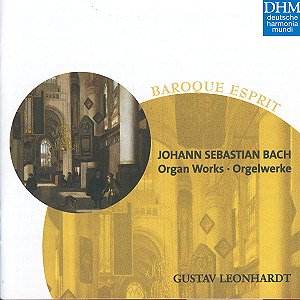This is a remarkable CD, featuring an excellent
historic organ and an excellent performer in a programme
with J.S. Bach’s music.
The disc seems to be above all an
exploration of the Hagerbeer/Schnitger organ
through music that shows off its colors. The connections between the
compositional forms and techniques, and that of the organ building techniques
of that period, are also presented in this CD.
The booklet contains nothing
but an extensive account of the history of the organ, given in three
languages. A reference though to the performer’s selected registrations
would be helpful for the listener in order to distinguish the different,
unique stops of the organ. The originality of this Alkmaar organ is noteworthy. The restoration of 1982-6 by Flentrop was carried out with strict conservation in mind
thus the organ has most of its original pipes and its original key action.
In 1639 the famous organ
builder Van Hagerbeer started work on this
organ. The case was designed by Jacob van Campen,
whereas the closed organ windows presented a momentous painting by Caesar
van Everdingen called The triumph
of King Saul after the defeat of Goliath by David, which has
been restored in its original colors. As the booklet points out,
‘the case of the organ of Alkmaar is
in many respects nationally and internationally unique… it is a masterpiece
of classical architecture and the first organ in Holland with a sculptured
decoration underneath the positive’. In 1722 Gerhardus
Havingha was appointed organist and was responsible
for the drawing of an entirely new organ within the old one. Frans
Caspar Schnitger
signed the contract for a new organ and by 1725 this instrument was
the first in the Low Countries to be tuned in equal
temperament. It also still retained the old north German terziand and zimbels stops, and
followed the new idea of the period to produce massive effects in terms
of sound through the use of many manual couplers. Therefore it stands
as a crucial indication in assessing Bach’s maturity and giving another
aspect to that of G. Silbermann, Hilderbrant
or Müller’s organs. Other new ideas presented in this organ were
the Flachflöte 2’ on the Hauptwerk,
which became a solo stop, and the Viool di Gamba 8’, placing at the back
of the case and thus its imitation was quite fascinating.
The Toccata in D minor
BWV 913 was written for harpsichord with the opening section includes
a solo bass line, typical of organ pedal parts. Its third section is
developed more melodiously than in pure organ toccatas. The four chorale
arrangements were to be played on two manuals either as an echo effect
or melody with accompaniment. The Clavierübung
III was Bach’s first publication for organ, published in 1739, a year
celebrating Luther’s reformed liturgy and reformed doctrine. It contains
miscellaneous pieces of various compositional forms. Half of the hymn
melodies in the chorales are of Gregorian origin. Spitta
admired the Prelude and Fugue in E minor BWV 533 for its expressive
qualities such as ‘gloomy pride…melancholy…magic…gentle strength’.
Apart form the interest
of listening to this finely restored historic instrument, there is the
pleasure of Leonhardt’s persuasive interpretation.
By combining brilliant technique with rhythmic sharpness, and rich expression
with nicely played ornamented vocal lines, Leonhardt
achieves a true mastery of Bach’s music on the organ. There is nothing
boring about his performances; they are simple and display a characteristic
vitality and individuality. The qualities of the organ seem also to
aid Leonhardt’s zestful style. The registrations work well and
all the lines of the texture are carefully etched. The only criticism
would be that of occasionally clipped touch in the fast tempos, which,
even though it gives energy, lets loose a full
sound that sustains within the building’s acoustics.
Christina Antoniadou


